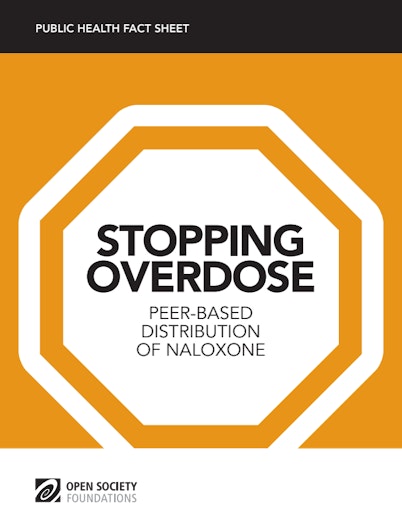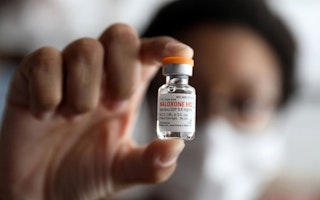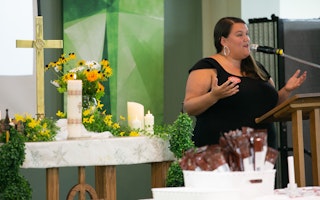How to Stop Overdose Deaths in New York
By Roxanne Saucier
April brought two big developments in the battle to combat heroin and opioid drug overdose: the New York Attorney General announced a program to use $5 million to equip police with the overdose antidote naloxone. The same day, a new naloxone auto-injector device, called Evzio, was approved by the U.S. Food and Drug Administration. We sat down with Matt Curtis, the policy director of VOCAL New York, to discuss what these developments mean.
New York’s Attorney General is proposing to use $5 million to equip every state and local police officer with the overdose antidote naloxone. Is this a breakthrough for overdose prevention?
Yes and no. In some parts of the state police officers are frequently first on the scene at an overdose, and by equipping them with naloxone they will now have the ability to save lives. But this is not the whole answer.
Despite New York’s 911 Good Samaritan law, not everyone will call 911 for help during an overdose. There’s also no reason to make people at the scene of an overdose wait for the police or an ambulance to arrive when they could be responding themselves. Study after study has shown that bystanders and non-medical professionals are fully capable of providing appropriate first aid, including administering naloxone. And during an overdose, every second counts.
After nearly 20 years of community-based overdose education and naloxone distribution programs in the United States we know that people who use drugs, their friends, and their family members always have and always will be the best first responders during an overdose. What’s missing in most of the stories about Attorney General Schneiderman’s announcement is any mention of this work in New York State. We’re now looking to engage with the Attorney General’s office to make sure that law enforcement is able to learn from the dozens of programs around the state that have paved the way.
While the new law enforcement program is a positive step, the resources being dedicated to it are in stark contrast to what’s on offer to community programs that are desperately needed, and are chronically underfunded. In 2013, total public funding from the New York state and city governments for these programs was well under $1 million.
The money mostly went to buy naloxone kits, but also to support basic program infrastructure and pay a handful of prescribers. Though it’s difficult to come to an exact figure, the total national investment for community naloxone programs is likely less than what New York will dedicate to this police program alone.
It’s important to acknowledge that asset forfeiture money can only be spent on law enforcement, so this is certainly not a matter of the Attorney General making a bad decision. But we need our state legislature and the NYC Council to appropriately dedicate funds to naloxone and overdose prevention that are commensurate with the scale of the overdose epidemic.
The other big news this week was that the FDA approved a new naloxone product—an auto-injector called Evzio. Will this new product make naloxone more accessible for those who need it most—people who use opioids?
The last thing advocates have been asking the federal government for is an expensive, prescription-based naloxone delivery device. What we need is for federal agencies like the National Institutes on Drug Abuse and the FDA to incentivize development of low-cost, over-the-counter naloxone—a very feasible goal.
Evzio on its own looks like a great product, but it has at least three major downsides in the context of community-based overdose prevention programs:
- Though a price has not yet been announced, if it’s in line with other auto-injector devices—like epinephrine injectors for allergic reactions—then it is likely to cost in the hundreds of dollars a device.
- And, while insurance plans may reimburse for it, this price would put the device out of reach of community-based programs that have limited budgets, and that routinely distribute multiple doses to people after they are trained to use it.
- A high price for Evzio may encourage the other naloxone producers in the U.S. to increase their prices, as well. In fact, one of the main producers, Hospira, recently announced that they're raising the price of their product. There will be major consequences for community programs if this marks the start of significant price increases.
The combination of price increases and inadequate public funding for overdose prevention programs is a longstanding issue. For more background, I’d encourage you to watch Reach for Me: Fighting to End the American Overdose Epidemic.
What are the top priorities for reducing opioid overdose in New York State?
We recently released a briefing paper describing policy changes that we think are needed to end New York’s overdose epidemic. One of those changes is reflected in legislation introduced earlier this year that would allow standing order naloxone prescribing—enabling staff at harm reduction programs and other agencies to distribute naloxone directly without a doctor or other prescriber present. The legislation would also allow pharmacists to dispense naloxone to eligible people without a prescription. The bill unanimously passed our state Senate a couple weeks ago, and we expect an Assembly vote later this month.
Beyond naloxone, we need to improve access to drug treatment, especially opioid substitution therapy with methadone or buprenorphine. New York City would benefit tremendously from supervised injection facilities (SIFs) like Canada’s very successful InSite program. We have a huge population of homeless or unstably housed injectors here, and SIFs have been rigorously studied and shown to reduce not only overdose, but also HIV and viral hepatitis transmission, and public disorder.
And beyond the level of public health interventions, the best thing we can do to stop overdose and other drug related harms is to end the war on drugs. Our country has put a trillion dollars into the drug war over the last four decades, incarcerated tens of millions of people, and it’s been an utter disaster. We take this especially personally in New York, where the Rockefeller drug laws incubated many of the worst policies in the early 1970s.
That’s our bigger goal here. No one should be getting arrested for simple drug possession, and no one should have a judge making medical decisions about drug treatment for them. So, to answer your question: Evidence-based public health strategies, alongside a basic approach that values dignity and compassion rather than punishment, are what will win the battle against overdose deaths.
For more information about naloxone, visit naloxoneinfo.org.
VOCAL New York is a grantee of the Open Society Foundations.
Roxanne Saucier is a researcher and analyst for the Open Society Public Health Program.


